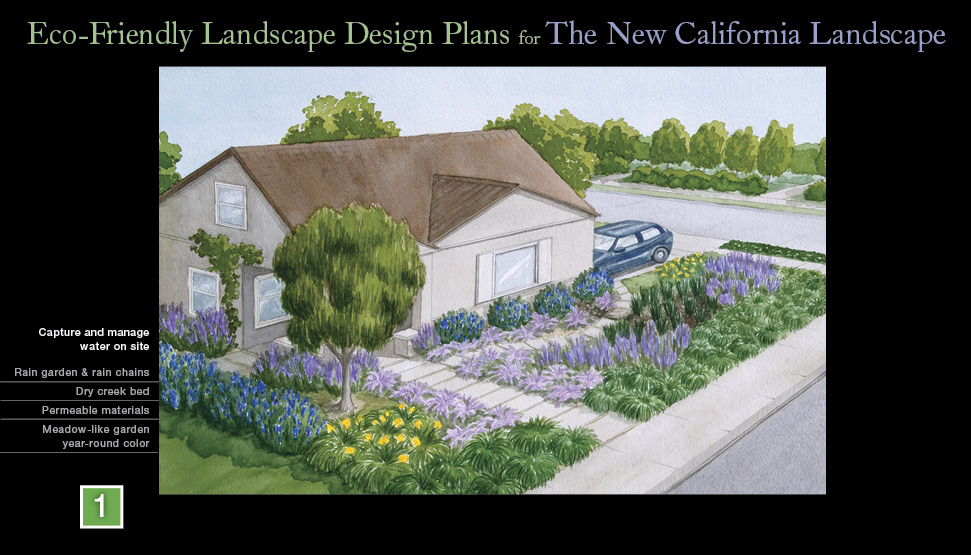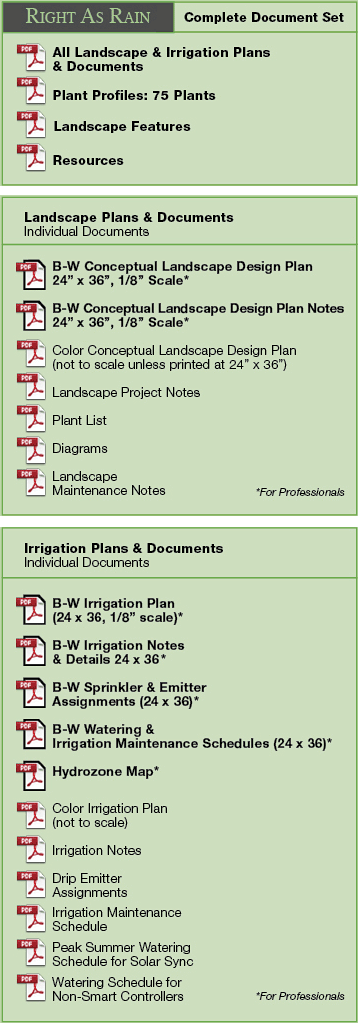

Conforms with the guiding principles of Eco-Friendly Landscaping


What could be more eco-friendly than the on-site capture
and use of water from irrigation and storm events? This
landscape includes a variety of permeable materials and
elements to achieve just that. A number of walkways
provide easy access to all parts of this landscape so the
year-round color plant palette can be enjoyed.
Front Yard
- Water from downspouts is channeled toward the dry creek bed
and into the Rain Garden where it will collect and slowly soak into
the ground, using the “slow the flow” principle for seasonal water
management, which keeps water in the landscape instead of going
into storm drains, streams, and rivers. - Plants for the Rain Garden are selected because they can thrive
with seasonal rains, yet tolerate drier months. - Consistent with the principle to reuse materials and less to the
landfill, soil excavated to make the rain garden depression was
reused to create the adjacent berm planted with European Gray
Sedge (Carex divulsa), adding movement to the garden and evoking
a meadow-like style. - This corner property is subject to extensive exposure, not only to
the sun, but also to heat from the street and noise from traffic. A
sound barrier, visual screen, and “wall” of privacy are created with
the layering of evergreen California native shrubs and installation of
a fence. - Additional on-site water retention is achieved through the installation
of permeable pavers, gravel and stepping stones used across the
driveway and for patios and walkways.
Back Yard
- When lawn is needed for family, pets, and activities, use of a
low-maintenance lawn, such as a native “Mow Free”, can be the
perfect solution. It can be left unmoved for a natural, meadow-like
appearance. - Strategically positioned “rain chains” bring the soothing sound of
trickling water into the garden. - A back yard patio provides a casual, shady retreat, which includes
an overhead shade structure and permeable plum-colored pea
gravel, neatly and discretely retained with metal edging. Another
spacious patio lends itself to entertaining and Barbequing.
Plants
- Using California natives and UC Arboretum All-Stars ensures that
the durable plants selected for this landscape are well adapted
to our climate and soils, resulting in cost saving due to lower
maintenance and less plant replacement. - Plants are the right size for the space. Proper spacing and
placement, along with proper care, results in little to no pruning and
allows plants to grow to their natural form without outgrowing the
space. - The red flower color of the Little John Bottlebrush (Callistemon x
viminalis ‘Little John’), Rosemary Grevillea (Grevillea rosmarinifolia),
and Hummingbird Sage (Salvia spathacea) are softened with the
silvery green-gray of the Little Ollie Dwarf Olive (Olea europaea
‘Little Ollie’), Compact Texas Ranger (Leucophyllum frutescens
‘Compacta’), Walker’s Low Catmint (Nepeta x faassenii ‘Walker’s
Low’), and Lamb’s Ear (Stachys byzantina). - Natural wood mulch on soil surfaces in planting areas helps to
reduce weed growth, retain soil moisture, moderate the soil’s
temperature, reduce erosion, and protect the soil from compaction,
and add organic matter that feeds beneficial soil organisms.
Irrigation
- Irrigation optimized for peak water efficiency.
- Valve zones are apportioned into “hydrozones”, where plants of
similar water needs are grouped together, and watered at the same
time. - The lawn sprinklers use high-efficiency nozzles.
- All plants are watered with “inline” drip tubing with built-in emitters.
- A smart, weather-based controller is utilized for daily adjustment of
the irrigation schedule to respond to changes in the weather. - Multiple flush points are specified for easier maintenance of the drip
systems. - During unusually dry winters and in drought conditions,
supplemental watering may be necessary, especially for California
natives and plants in rain gardens, because these plants rely on winter
rains to sustain themselves.